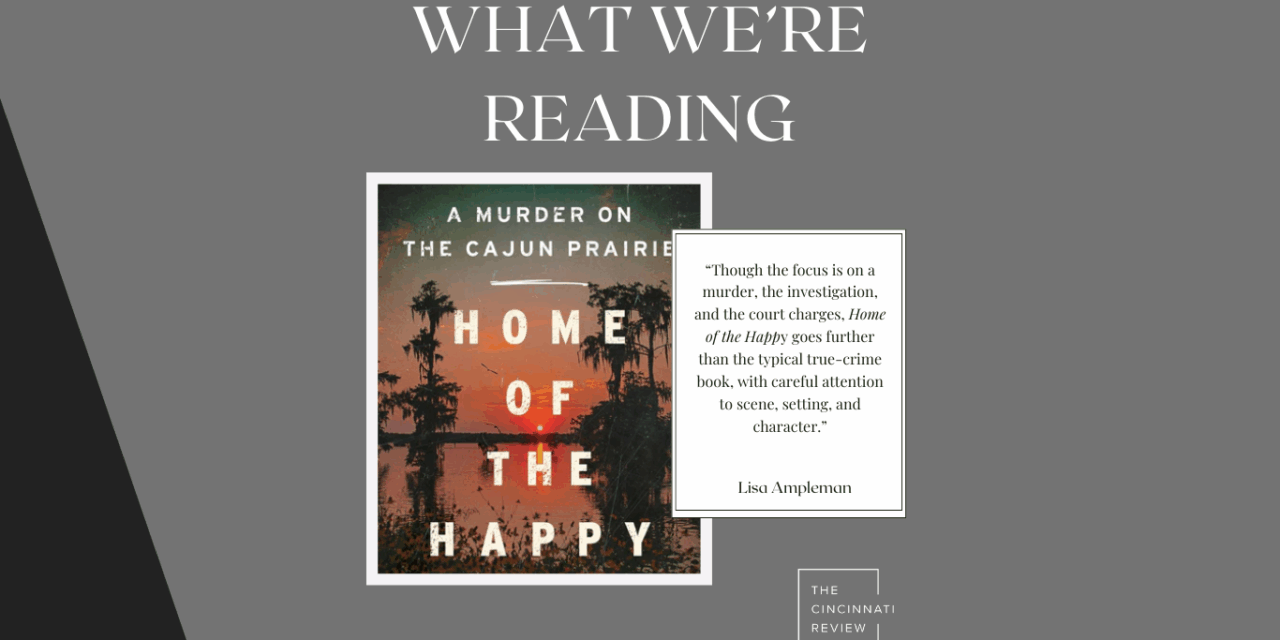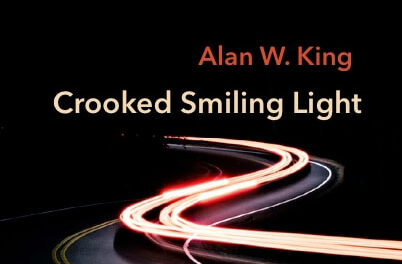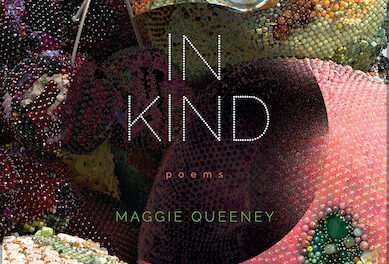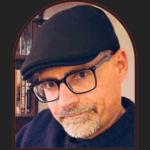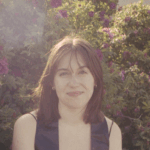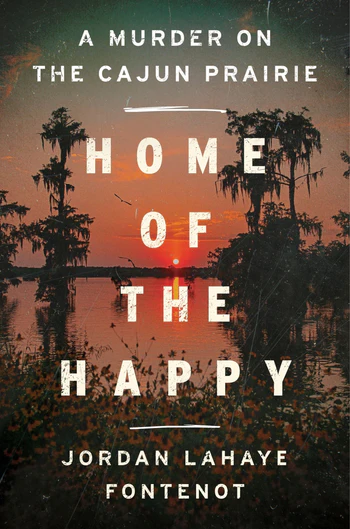
Managing Editor Lisa Ampleman:
Lately I’ve been reading a lot of nonfiction about family histories, in part because I’ve been thinking about my own quite a bit (see my sister’s and my tribute to our great-uncle, who had been estranged from the family, here).
Some of my favorites have approached their content in part through letters or family documents: Sylvia Brownrigg’s The Whole Staggering Mystery (Counterpoint, 2024), in which she explores her grandfather’s life through a narrative written by his mother; Jessica E. Johnson’s Mettlework (Acre Books, 2024), which meditates on her childhood in mining camps but also on motherhood, using some of her mother’s letters written during that time; and Cristina Rivera Garza’s elegy for her sister, Liliana’s Invincible Summer (Hogarth, 2024), in which she searches out documents about her sister’s death, including letters Liliana wrote.
Mostly recently, I read Home of the Happy: A Murder on the Cajun Prairie (Mariner Books, 2025) by Jordan LaHaye Fontenot, recommended by a cowriting pal from the summer, Kristina Pepelko, who knows the writer. In early 1980s Louisiana, LaHaye Fontenot’s great-grandfather, Aubrey LaHaye, was kidnapped and murdered, which had serious repercussions on the large, close extended LaHaye family in the area. It’s wowed me because of its distinctive approach to craft, using the tools of fiction and the eye of a journalist to tell a story about a family tragedy that happened before the writer was born.
Ethically complex true-crime
Though the focus is on a murder, the investigation, and the court charges, Home of the Happy goes further than the typical true-crime book, with careful attention to scene, setting, and character. It’s a personal story in the end—not just something described in microfiche newspaper accounts but an event that shaped the LaHaye family. In an early chapter, as she describes looking through digital newspaper archives, LaHaye Fontenot says:
A dissonance claws within my chest each time I read the names I recognize so well, MawMaw’s, my grandfather’s, my grandmother’s. Each time I recognize the courtyard in the photographs beneath the headlines—the same house . . . where we to this day gather for Easter, Christmas, baptisms, birthdays, bridal showers. . . . I read the reports again and again, trying to reconcile the layers of my reality with this one. The revelation feels ridiculous, and almost embarrassing—that this story had felt so distant, so mythic, when I heard it as a child. Somehow, I had failed to realize it happened to the people I love.
A few years back, we had a special feature on the craft and ethics of crime writing, and this book handles those well, focusing on the real people, not the sensational details. It’s even-handed and complex in its treatment of the major suspect, and it draws a fully realized picture of the victim too.
Devotion to scene
Our literary nonfiction editor, Kristen Iversen (on sabbatical this semester), says that the genre requires the writer to “Think like a poet, write like a novelist, tell the truth.” Most of the events LaHaye Fontenot describes happened thirteen years before she was born—but one major strength of the book is its commitment to scene. We see the bank tellers at her great-grandfather’s bank looking at a sketch of a suspect; we’re in the Catholic Church for Mass the Sunday after Aubrey LaHaye has been kidnapped; we’re a fly on the wall for the trial of the main suspect. LaHaye Fontenot has the skills of a novelist in her setting of scene, with crisp dialogue (some quoted, some invented), clear characterization of the many members of the complex extended family, and immersive description.
She has the access and education of a journalist, but she uses those tools of literary nonfiction defined by Iversen well. Here’s a poetic description of setting early in the book, on the morning her great-grandfather was kidnapped:
In those predawn hours, a soupy fog spread itself across the Mamou prairie—soaking up the first struggling strands of sunlight, then dissolving them into extended gray. In houses up and down LaHaye Road, men rubbed their eyes and peered out their windows toward the flooded rice fields, listening for migrating ducks. Unable to see even into their backyards, they dialed each other, one by one, to call off the morning’s hunt.
With moments like these, she put me in Evangeline Parish in 1984.
Characterizing a place
In fact, the book is about a place just as much as a crime. As a Midwesterner, I found myself in the cities Ville Platte and Mamou in southern Louisiana, a Cajun community, to the extent that I felt like I had visited. And I learned that Henry Wadsworth Longfellow’s epic poem Evangeline narrates the journey of the Acadians from the Canadian Maritimes and Northern Maine to Louisiana (its subtitle is “A Tale of Acadie,” so that’s on me!).
LaHaye Fontenot acknowledges the broad reach and influence of her family in the area—the road they live on has their name, for example—brushing up against the realities of privilege. More than half the jury pool for a key trial had close connections to the LaHaye family or the suspect, for example. “Relatively early in the selection,” LaHaye says, “the pursuit of the gold-standard unbiased juror was abandoned, as the small town folded in on itself, the interrelations of family trees, schoolyard memories, and business dealings distilled into a question of proximity. ‘Are you close enough to be affected by your role in this man’s future?’ . . . And these twelve, with their various problematic associations—well, this was as close as they could get.”
Home of the Happy complicates the nature of the writer’s connection to and love for the place, but not in a way that erases those ties. Some family members aren’t happy with where her research has taken her, and say so— “You lit a fire, huh?” her Uncle Richard says outside of a court hearing—but she doesn’t become estranged from any and even mentions being at a family wedding in the epilogue. She proceeds with a critical eye for accepted truths within the family and with empathy for those with whom she disagrees. In the end, she knows, she can tell the story because of her differences from most other LaHayes, with her lack of a Cajun accent or knowledge of French, and “never having experienced true, devastating loss in my entire life.” Her great-grandfather was long-dead as she was growing up in the family.
It’s this otherness, this sense of looking at it all from three steps away—this is what enables me to tell the story. This is what protects me, keeps the veil in place. There’s this world, and then there’s my world.
This emotional remove is a craft choice, as is the metanarrative move of pointing it out. I admire LaHaye Fontenot’s instinct to do both.
Lack of closure
The true-crime genre often includes plots where law enforcement find the suspect and solve the crime. However, in this case (as in many others in the US), the mystery isn’t solved; the culpability of the main suspect isn’t crystal clear. “Life, as we know, is messier than story,” LaHaye Fontenot says in the epilogue. “In my pursuit for answers, I’ve found myself with more questions than before—awaiting resolution that feels ever-imperfect, and like it may never come.”
The book’s ending itself doesn’t lack literary/artistic closure, though. LaHaye Fontenot updates the facts as far as she can with the book’s publication-schedule limitations in mind, and she does it in a way that honors the story, her family, and the suspect.
It’s clear that she spent years of her life searching and writing the story, and she does so with skill. This is a family history book that will linger with me for a long while.

